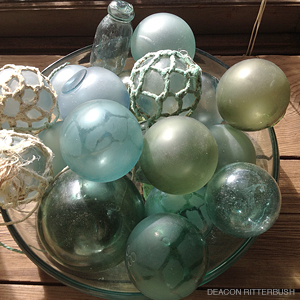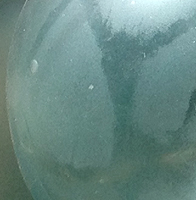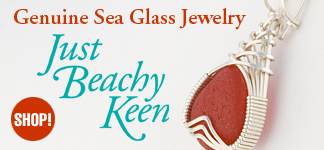Glass Fishing Floats

See LARGER IMAGE
Is there anything more magical than a "sea bubble" bobbing in on a coming wave or peeking out from under a wrack of seaweed? Not to me. Glass fishing floats are one of my favorite beach treasures for many reasons: their beauty, their history, their journey, their resilience and the joyful quality they exude whenever the sun reflects off of them. These floats are one of the rarest, most coveted beachcomb finds. But they don't turn up on just any beach, no matter how hard you look. In fact, not only location but timing, skill and, yes, luck, all come into play when it comes to finding a glass fishing float.
History
It is believed glass floats were first used in Norway, circa 1840, when fishermen began tying small, egg-sized floats to fishing lines and hooks. Norwegian merchant, Christopher Faye, is credited with the popular invention as a means to make Norway's cod fishing industry, undertaken in the frigid Arctic, North Sea and North Atlantic waters, more efficient.

A close-up of the diamond-shaped pattern of distinctive spots left after the netting falls off.

Deacon Ritterbush is promoting the 7th Annual Beachcombing Conference on the island of active volcanoes, snow, sea turtles and black sand beaches. Learn more about what you find on the shore from beachcomber authors, artists and experts, then shop 'til you drop at Hawai'i's 1st Sea Glass Festival on May 15th.
For up-to-date details and more info visit 2016 Beachcombing Conference.
The technology began to be picked up elsewhere — by the Portuguese, Russians and, in the early 1900's, the Koreans, Chinese, Taiwanese, and especially the Japanese with their large deep sea fishing industry, all adopted the technology with great enthusiasm.
 |
It is believed glass floats were first used in Norway, circa 1840... |
 |
Floats were laced with cording and then woven into the rope line of long fishing nets. They offered nets plenty of buoyancy and provided an economical method of supporting fishing nets, long lines and drop lines.
Soon fishermen were stringing miles of fishnets and fishing floats together and setting them adrift in the ocean. As the use of nets increased, Norway went on to produce other sizes and shapes of floats. Inevitably, the rough currents, high waves and strong storms ripped many floats from their "mother nets."
Currents and waves scattered many of them thousands of miles across the ocean. Many were destroyed. Others floated for decades in turbulent seas. Others miraculously, managed to survive their tumultuous sea journeys and wash ashore, intact, somewhere else. These floats symbolize a journey of hope to me, which is why I surround myself with them in my home - to remind me that I can float through tough times, too.
Manufacturing process
Fishing floats come in a range of sizes (from 3 inches to a jumbo basketball size) and shapes, including round and rolling pin and some have very distinctive macramé cording.
The earliest floats, including most Norwegian and Japanese floats, were handmade by a glassblower. In the case of Japan, recycled glass from old sake bottles were commonly used. Sometimes, air bubbles in the glass resulted from the rapid recycling process.
After being blown, floats were removed from the blowpipe and sealed with a glob of melted glass before being placed in a cooling oven. This lump of melted glass is referred to as a blob seal. Some mistakenly identify blob seals as pontil marks but pontils were not used in the process of blowing glass floats. The little glass button situated inside some floats are called nubbins or blob buttons.
A later manufacturing method used by the Koreans and Russians was the use of wooden molds to speed up the float-making process. Glass was blown into the mold so that it could more easily and quickly achieve a uniform size and shape. As a result, these floats have seams on the outside.
While floats were still hot and soft, 'makers marks' were often embossed on or near the sealing button to identify the manufacturers of the floats. Russian and Korean floats generally have maker's marks on the sides. Japanese and Norwegian maker marks are usually stamped on the blob seal. Along with shapes and colors, maker's marks offer another way for beachcombers and collectors to identify the origin of found floats.
In the mid-20th century, the more durable cork and aluminum floats began to replace glass floats, especially since they could provide holes or eye features that made net attachment easier.
By the 1960's, plastic and Styrofoam floats (sadly!) took hold.
Where to find them
Although the number of glass floats is decreasing steadily, many are still drifting in a circular pattern of ocean currents in the North Pacific. Occasionally storms or certain tidal conditions will shift some floats out of this circular pattern and carry them to shore. Sometimes, several may arrive together in the same location. Often, these floats roll safely onto shore or may be tangled in seaweed or other flotsam. Others end up breaking just as they reach shore, especially if the shoreline is rocky.
To find a fishing float these days, you definitely have to be at the right place at the right time and even then, luck plays a big part in the discovery. But your chances are heightened if you beachcomb in the right areas. So where do they most often turn up? Hokkaido, Japan. The outer reaches of Alaska. Sometimes on mid-coast Oregon and Washington beaches. Occasionally still in Hawai'i and throughout beaches in Micronesia and Polynesia. And sometimes, you can still find some in the Atlantic, on remote islets in the Caribbean islands or even in Europe.
Many beached glass floats show distinctive wear patterns from the corrosive forces of years in the elements of salt water, sun and eventually sand. Once a float lands on a beach, for instance, it may roll in the surf and, over time, become "sand-blasted." If it has retained its netting, the glass between the net loops becomes etched. If the protective netting falls off, the surface of the float is "decorated" with a diamond-shaped pattern of distinctive spots. (Some of us call these floats 'leopards' because of such spots.) Other floats have barnacles attached to them or water trapped inside, which may have leaked in through microscopic imperfections.
Sometimes you find only part of a float but shattered floats can yield lovely shards of sea glass or the rare, wonderful "Mermaid Nipple," which is the sea-and salt spray-smoothed blob button/seal.
Nowadays, some floats, especially the Norwegian ones, are in great demand by collectors and can command high prices on the coastal antiquities market. Also coveted are floats with specific stamps or Kanji marks, interesting swirls or blob buttons; of particular shape or size; or floats in rare colors such as olive green, brown, teal, amber, turquoise, purple, pink, red and gray. But even the common Japanese floats, though not as costly, are well-loved and pleasing to the eye.
How to tell if authentic
Authentic glass floats are heavier then commercially made ones and most usually have bubbles in them. Most floats tend to be the colors mentioned above and show some wear. If there are no signs of wear and tear, a float may have never actually been used, or was protected by a plastic sheathing (a technology adopted in the 1960's), or it is not an authentic fishing float. The bright, brilliantly hued floats on the market today are replicas, produced for the tourist market.
Over a lifetime of beachcombing, I have only found five floats, all of which were discovered on island shorelines in the South and North Pacific. I treasure each one, both their beauty and also for what they symbolize. They are reminders that, yes, life can be hard, and I will go through rough seas over the course of my lifetime. But like these lovely, resilient floats, I can survive my tough times and treacherous seas, too, if I just remember to lie back and float, trusting that life's currents will eventually carry me to a safe haven, too.
Dr. Deacon Ritterbush, also known as Dr. Beachcomb, is author of the award-winning book, A Beachcomber's Odyssey: Treasures from a Collected Past. She is also founder and coordinator of the annual International Beachcombing Conference. To learn more, visit www.drbeachcomb.com. You can also find her on Facebook or Instagram under Dr. Beachcomb.






